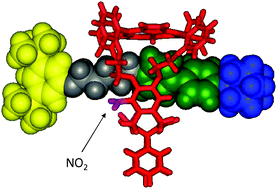Monday, December 24, 2018
Artificial polymerases
Saturday, October 5, 2013
Cooperative Catalysis
 We recently prepared a similar natural mimic, a bimetallic nano-porous catalytic system, which would be able to perform cooperative catalysis for the selective synthesis of ortho-prenylated phenols and 2,2-dimethyl chroman, starting from phenol and allylic alcohol. Prenylated phenols are widely distributed in nature and are known to be an important structural unit of pharmaceutical compounds. Similarly, 2,2-dimethylchroman derivatives also exhibit broad range of interesting physiological properties, we are able to synthesis the important structural motif by using the new cooperative catalytic systems.
We recently prepared a similar natural mimic, a bimetallic nano-porous catalytic system, which would be able to perform cooperative catalysis for the selective synthesis of ortho-prenylated phenols and 2,2-dimethyl chroman, starting from phenol and allylic alcohol. Prenylated phenols are widely distributed in nature and are known to be an important structural unit of pharmaceutical compounds. Similarly, 2,2-dimethylchroman derivatives also exhibit broad range of interesting physiological properties, we are able to synthesis the important structural motif by using the new cooperative catalytic systems.Wednesday, May 8, 2013
Click Chemistry for Pyrrole Synthesis
Sunday, February 17, 2013
Useful chemicals and fuel from carbon dioxide
- CO2 has a strong affinity towards nucleophiles and electron-donating reagents due to its carbonyl-carbon's electron deficiency; if the designed catalysts has nitrogen or base-functionality (basic), it will have an increased affinity towards CO2 (e.g., Porphyrin, Grignard reagents).
- With low-valent metals and alkene, CO2 undergoes “oxidative cycloaddition.”
- New CO2 soluble catalysts may increase efficiency.
- Homogeneous catalysis in compressed CO2 may increase selectivity.
- The catalyst in supercritical CO2 may also increase stability. It is essential to use CO2, based on the unique physical properties as that of the supercritical fluid, either as a solvent, or as an anti-solvent, or reactant, or a combination of all.
- Photoelectrochemistry, the study of using solar energy to split CO2, is an emerging method for clean production of chemicals. It is also essential to develop catalysts (Semiconducting materials) for the electrochemical conversion of CO2.
- The use of high-energy starting materials may ease the catalyst role.
- The catalyst will be more efficient if it has both CO2 adsorption and activation functionality. E.g., designer MOF that contains Lewis-base sitewill donate electron to CO2, in contrast to the Lewis-acids sites in traditional MOFs for adsorbing CO2.
- A computational tool such as Density Function Theory (DFT) may help improve the catalytic activity or find a new catalyst.
- Chemical reactions can also benefit from using CO2 as a mild oxidant or as a selective source of O2 atoms because dissociation of CO2 on a catalyst-surface could produce active O2 species.
“Some of the most interesting problems in science, and many of the most important facing society, need chemistry for their solution. Examples include: understanding life as a network of chemical reactions; interpreting the molecular basis of disease; global stewardship; the production, storage, and conservation of energy and water; and the management of carbon dioxide."
Friday, February 1, 2013
Artificial Photosynthesis using graphite Carbon Nitride
Sunday, January 22, 2012
Nano reactions
Wednesday, September 26, 2007
Cyanation of aryl halides
Potassium hexacyanoferrate(II) has been used as a cyanide source. This result increases the list of metal-catalyzed reactions that can be performed without ligand.
This method's advantage is obvious; in contrast to other cyanating agents, potassium hexacyanoferrate(II) is less poisonous# and can be handle without special precaution due to the slow release of cyanide ions. Additionally, it significantly improved catalytic productivity compared to know procedures achieved previously.
#( KCN is extremely toxic (LDL0(oral, human) =2.86mg Kg-1 and develop HCN on contract with acidic water. K4[Fe(CN)6] is non-toxic and used in the food industry for metal precipitation in wine. Also, it has been used as an anti-agglutinating auxiliary for NaCl (table salt). It is soluble in water without decomposition. Schareina T et al, Chem Commun., 2004, 1388-1389.)








